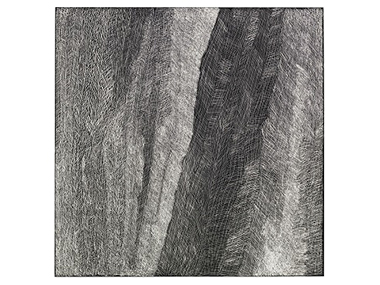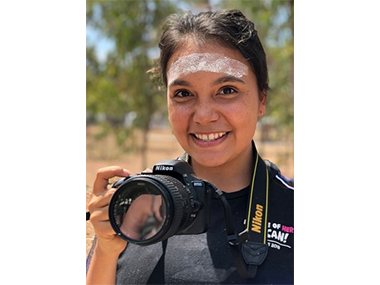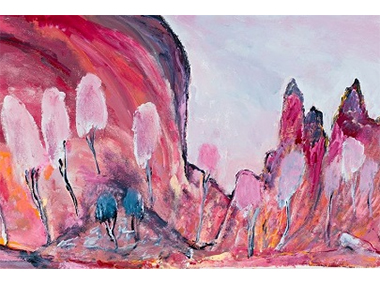“The Art of the Nation”

'Wirrkanja', Ngarralja Tommy May's etched image of a claypan near Kurtal, its waters flowing around rocks and caves
Posted by Jeremy Eccles | 07.08.20
Gallery: Museum and Art Gallery of the Northern Territory
Dates:
08.08.20
: 31.01.21
“Thank you mob in Darwin for this business. Thank you. At last. I feel proud. I’ve been trying all my life, all the time second, fourth, last, sometimes nothing. But I got it now, today. My day, my time this year, I’m the winner. At last.”
That was the glorious response of the 'Big Telstra' winner, 85-year-old Ngarralja Tommy May to his triumph in his third appearance in the finals of the National Aboriginal & Torres Strait Islander Art Awards after many more entries. It surely reveals how important this event is for artists; and how competitive they are to win an award there.
Tommy May is a Wangkajunga and Walmajarri man, born in the Great Sandy Desert. He paints, dances and sings Kurtal, a ceremony relating to the main jila /waterhole in his Country. “I was big when I left my Country. I was already hunting by myself”, May was, in fact, one of the last of his people to head out of the desert to work on the cattle properties of The Kimberley around Fitzroy Crossing. As a result, he adds, “I know these stories and these places in my country. I paint these now. I first saw paintings in caves. I learned a lot from people, mostly my father and grandfather. When I paint I think about this”.
Intriguingly, the earlier art he created for his NATSIAA appearance in 2001, for the Ngurrara Canvas and for the Canning Stock Route exhibition was quite different. But in 2013, he attended a workshop with the Melbourne Blak artist, Reko Rennie, was given a posca pen and a fluoro board to mark on to, and his development into a master of creating images of rain, rocks and sand dunes on Country with an infinite variety scratched lines began. “My work is now like my drawing for printmaking, straight on to the tin, sometimes wood, using a knife or pens. I work every day”.
And he's always been a proud promoter of the Mangkaja Art Centre – which he helped to found – becoming its Deputy Chair as well as the chairman of Kimberley Aboriginal Law and Cultural Centre and being a director for twenty-one years of the Association of Northern Kimberley and Arnhem Aboriginal Artists.
Unfortunately, as NATSIAA judge Stephen Williamson – curator at the Araluen Art Centre in Alice Springs – admits, “You do really need to see Tommy's work in the flesh – it just hums, it vibrates. And my fellow judge, Injalak Arts director, Donna Nadjamerrek told us she could feel his Country in the work without ever visiting the deserts”.
The third judge in this COVID year was Darwin-based artist, Karen Mills – for, of course, the NT has been resisting interstate visitors. Despite which the Museum & Art Gallery of the NT received 258 entries in March, just 50 down on last year. While Tommy May and the youthful Cecilia Umbagai are West Australian, all the other winners have an NT connection – however tenuous! For instance, Jenna Lee may live in Melbourne currently, but she rates her Larrakia connectedness in Darwin highly, is the niece of local photo artist Gary Lee who had a fascinating finalist work 'improving' a Paul Foelsche photograph of a 19th Century Larrakia man, and may well be related to the political sloganiser Jason Lee, who also made it into the finals for a work on paper.
But Jenna won the Wandjuk Marika 3D Memorial Award for 'HIStory vessels', a series of shapes created by repurposing a children's book, 'The Ladybird Story of Captain Cook' – pulping, decouping and turning its pages into string to weave a pot. Why Capt. Cook when the poor old mariner had virtually nothing to do with the colonisation of Australia? “I was trying to understand all the planned revelry for his 250th anniversary”, Lee told me. “This is a multi-cultural, multi-lingual nation, and I just thought he's a Brit, he's not me, and I'm pretty Australian. So, why not re-write the 'national story' cheekily as a young, female, mixed-race and queer person – and proudly Australian!”.
Jenna Lee may be Japanese, Chinese, Filipina, settler and Aboriginal, but it's the Larrakia language which appears in much of her works – including the clever work 'Lyrebird', which was a finalist 2 years ago.
The only man to join the NT winners was Adrian Jangala Robertson from the wonderful Bindi art centre in Alice for disabled artists. His roaring red mountain-scape, which won the General Painting Award, is reminiscent of fellow Bindi-man, Billy Benn – the Macdonnell Ranges as great slabs of beef in the sky. “It's only a modestly-sized work”, pre-selector and MAGNT Indigenous curator Luke Scholes told me, “so it was a brave choice by the judges. And I really want to acquire it for the Museum, along with the beautifully refined pearlescence of the Tommy May”.
In contra-distinction to the Robertson, Iluwanti Ken from the APY Lands' Amata community won the Works on Paper Award for a 1.5 x 2.5 metre work, much larger than she's attempted before. 'Walawulu ngunytju kukaku ananyi (Mother eagles going hunting)' shows three fiercely protective birds in the sky over an impressionistic splash of Country – achieved amazingly in ink. “Its scale is so impressive”, marvelled judge Williamson. “And the energy of its story-telling. A real breakthrough for her”.
“I'm just teaching the kids so they can take over”, Ken told the press.
Back up in the west Kimberley, Worrorra woman Cecilia Umbagai has the Wandjina deep in her 23 year old soul. It was enough to win the Emerging Artist Award, using traditional bark to paint a work that is anything by traditional. The Wandjina's head stands proud, but his/her body appears to be decorated with food resources. Umbagai explained this as a reference to the iconic boab tree with its trio of valuable possibilities – water trapped in its trunk, its fruit to eat, and its height to climb “to find you way back home”.
Even younger than Umbagai, Siena Mayutu Wurmarri Stubbs is the 18 year old daughter of a name well-known to AAD – Buku Larrnggay's Director, Will Stubbs. Her maternal side is Ganambarr, but her Multi-Media winning work is a film set on a Shinkansen train in Japan! Does that make it 'Aboriginal art'??? “It's certainly art made by an Aboriginal person”, the feisty lass responds; “so it can't be dismissed – though I did wonder whether I should enter it. And, though my poem doesn't refer to it, I think it's enriched by knowing I'm Indigenous”.
Stubbs' very personal verse was partly evoked by the death of her grandmother just before leaving on a school trip to Japan – though that's not mentioned either. At last, in the quasi-enforced silence of the humming bullet train, zooming past villages and rice-fields at 270 kph, she has time to reflect. And the result is the very teenage fear, “I'm not ready for the future; let me float here in the present” to steer clear of the “stresses of tomorrow”. As Stubbs has already produced a book of Yolngu Matha bird photographs (aged 15) and works in Yirrkala's Mulka studio, she seems to be handling the stresses of today pretty well!
Finally, Best Bark, almost inevitably, also goes to Buku Larrnggay in the person of Marrnyula Mununggurr for the work, 'Muṉguymirri'. Although the title actually means 'small pieces' – suggesting a simple description of the appearance of the work, small squares and rectangles of delicate colour rather than the small bark shapes which has been the patter of her recent work – her insistence to the press was that though ”I'm changing my work, it's the same story of freshwater”. Is it pure abstraction then? For Luke Scholes, it's all part of the increasingly personal approach being taken by the women (including Siena Stubbs) at Yirrkala, “pushing themselves into unique categories”.
Once again, though, Stephen Williamson warns that the work needs to be seen in the flesh. Even on the wall, he says, “it's very understated – I really had to spend time to let it sneak up on me, looking from different angles to see the 3D form of a woven fish trap emerge”.
Intriguingly, the judges surely had to compare Munungggurr's work with that of her mother, Nonggirrna Marawili, which is a tremendous vision of 'Rough Gapu/Water' – all waves clashing and spray flying, and not a hint of pink, the colour that became all-too-omnipresent in Marawili's recent work. They may also have been tempted by the far more traditional story from Dhuwarrwarr Marika – 'Yalangabara' – the famous beach where the founding Djang'kawu sisters landed and self-fertilised themselves in order to generate the Dhuwa moiety of the Yolngu . This six-part bark and larrakitj work is a mighty 2 x 3 metres – hard to miss and provocatively entitled, 'Birth of a Nation' – not, presumably a tribute to the DW Griffith's racist film of the same name!
Coincidentally, it seems linked to the title of my story, 'The Art of the Nation', the words used by producer Rhoda Roberts to promote this year's NATSIAAs. Increasingly, that seems a just description of this gathering of the 65 finalists – no Tassie art, though work was offered by a private dealer, and may have been discriminated against, but all other states and territories were represented. And that included one, very strong work in ceramic and ghost net from Jimmy K Thaiday in the Torres Strait, reflecting on the parlous state of the Barrier Reef.
How can I leave out the rich and complex work of the 90 year old Ginger Wikilyiri or young Bessie Daylight's extraordinary portrait of her Mum – senior Gija artist Betty Carrington – as an angel? Can you even imagine how 15 different members of the Tjala Women's Collaborative managed to coordinate the huge, wild picturing of their 'Nganampa Ngurra'? And while Tommy May picked up his posca pen, Dallas Smythe from Warakurna employed a pyrographic pencil to make his burnt walka picture of an ironstone pebble plateau where myth was made. Finally, a welcome return by Titus Nganjimurra – last year's Telstra Emerging Artist with a cheeky pic of the Queen – this year taking the much more staid subject of the 'Barramundi' and moving on from traditional Arnhemland x-ray imagery to offer an almost perfectly realistic fish, with a wondrous core of backbone.
Share this:
»  del.icio.us
»
del.icio.us
»  Digg it
»
Digg it
»  reddit
»
reddit
»  Google
»
Google
»  StumbleUpon
»
StumbleUpon
»  Technorati
»
Technorati
»  Facebook
Facebook
Contact Details
Gallery: Museum and Art Gallery of the Northern Territory
Contact: Marcus Schutenko
Email: info@magnt.net.au
Telephone: +61 8 8999 8264
Address: 19 Conacher Street Fanny Bay 0820 NT
Gallery: Museum and Art Gallery of the Northern Territory
Contact: Marcus Schutenko
Email: info@magnt.net.au
Telephone: +61 8 8999 8264
Address: 19 Conacher Street Fanny Bay 0820 NT

The young Siena Stubbs, back from Japan in "the community which I love" at Yirrkala

A section of Adrian Jangala Robertson's Telstra General Painting Award winner, 'Yalpirakinu' (2020)
Where is the exhibition?
Further Research
Gallery: Museum and Art Gallery of the Northern Territory
Artists: Adrian Jangala Robertson | Bessie Daylight | Betty Carrington | Billy Benn | Cecilia Umbagai | Dallas Smythe | Dhuwarrwarr Marika | Gary Lee | Ginger Wikilyiri | Iluwanti Ken | Jason Lee | Jenna Lee | Jimmy K Thaiday | Karen Mills | Marrnyula Mununggurr | Ngarralja Tommy May | Nonggirrna Marawili | Reko Rennie | Siena Mayutu Wurmarri Stubbs | Titus Nganjimurra | Tjala Women's Collaborative
News Tags: Big Telstra | Captain Cook | Jeremy Eccles | Luke Scholes | Museum & Art Gallery of the NT | National Aboriginal & Torres Strait Islander Art Awards | Rhoda Roberts | Stephen Williamson | Will Stubbs
News Categories: Art Prize | Australia | Blog | Event | Exhibition | Feature | Festival | Industry | News
Exhibition Archive
- 12.08.20 | Fairs Fare
- 07.08.20 | “The Art of the Nation”
- 06.08.20 | The Salon, 2020
- 30.07.20 | EMILY v DOROTHY
- 15.07.20 | Repatriated Art at Auction
- 08.07.20 | Kaurna Shield Comes to Adelaide
- 02.07.20 | Yiribana
- 26.06.20 | Fashion Goes Indigenous
- 02.06.20 | RIP Malu Gurruwiwi – Custodian of the Banumbirr
- 11.05.20 | BIDYADANGA CLOSE-UP
- 07.05.20 | Boomerang Back to the Start
- 29.04.20 | Cooked???
- 24.04.20 | Mrs Ngallametta
- 23.04.20 | NATSIAA Pre-Selections Revealed
- 20.04.20 | CIAF 2020
Advertising

